Spanish Monastery
Click on a thumbnail photo to view the full picture.| 1 to 25 of 66 records |
|
| Next> Last>> | |
 |
Alfonso VII Coat of Arms The coat of arms of Alfonso VII chiseled into a wall of the Ancient Spanish Monastery. The picture of the lions and castles represent Castile and Leon a region in Spain. Alfonso VII was the king of Spain from 1135-1137. It is said that he introduced ... |
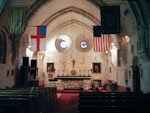 |
Chapel View of the chapel. The chapel was originally a dining hall for the monks living in the monastery, but it has now been converted into a chapel used by the Episcopal Church. The Episcopal Church as a whole began after the American Revolution after it ... |
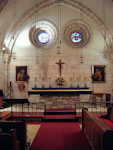 |
Chapel View of the chapel. The chapel contains numerous works of art. In addition to the ornamental architectural characteristics such as vaulted ceilings, arcading arches, columns, and telescopic stained glass windows, the chapel has two paintings hanging ... |
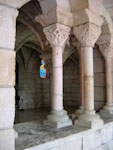 |
Chapter House View of the chapter house from the cloister. Notice the decorative columns, arches, and vaulted ceillings of the chapter house. There is also a stained glass window in the right corner of the room. |
 |
Chapter House View of the chapter house and cloister. The Cistercian monks of this ancient monastery began their days at midnight with a morning prayer service and another service at 3am. These services would take place in the dark until the use of candles began i... |
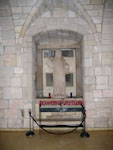 |
Christ the King Statue Christ the King Statue surrounded by prayer candles in the chapter house. This statue was sculpted in the 12th century possibly by one of the ancient monastery's own monks. The recess in the wall was originally used to hold holy water. |
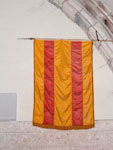 |
Civil and Mercantile Flag of Spain The civil and mercantile flag of Spain. These flags were flown by ships so that it was known that the ships were civilian and not military. They were more common in the past and usually resemble the national flag, but do not have the coat of arms suc... |
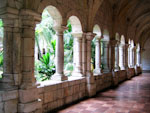 |
Cloister View of a cloister in the monastery. A cloister is part of a cathedral or monastery that usually has four corridors and a courtyard in its center as in the Ancient Spanish Monastery. |
 |
Cloister View of a cloister in the Ancient Spanish Monastery. Cistercian monks who orginally inhabited the monastery believed their lives should resemble the life of St. Benedict as closely as possible. This included performing manual labor and field work eac... |
 |
Cloister View of a cloister in the Ancient Spanish Monastery. The Cistercian monks that originally occupied the monastery believed that they should live according to the Rule of St. Benedict. The basic ideals of St. Benedict's Rule are peace, prayer, and work... |
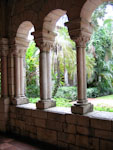 |
Cloister Columns and arches along a cloister in the Ancient Spanish Monastery. The typical day of the Cistercian monks who lived in the monastery included prayer, sleep, spiritual reading, and manual labor. |
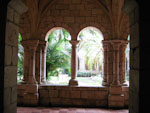 |
Cloister View of the cloister from the chapter room. The monks of this monastery lived by the Rule of St. Benedict. Examples of the Rule of St. Benedict within the daily lives of the monks include silence accept in necessary conversation, lack of private poss... |
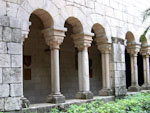 |
Cloister View of the cloister from the courtyard. This monastery was inhabited by a Roman Catholic order of monks, called Cistercians. They were also called "white monks" because they wore white or white and black garments. |
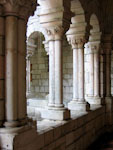 |
Cloister View of the cloisters in the monastery. |
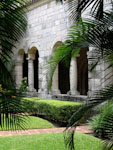 |
Cloister View of the cloister from the center courtyard. |
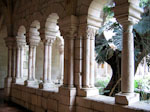 |
Cloister and Banyan Tree View of a cloister in the Ancient Spanish Monastery. The banyan tree in the courtyard is also visible through the columns of the cloister. |
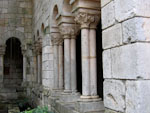 |
Cloister Walls View of the exterior walls of the cloister from the center courtyard. |
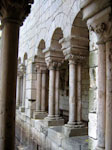 |
Cloister Walls View of the exterior walls of the cloister facing the courtyard. |
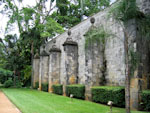 |
Cloister Walls The exterior walls of the cloister. |
 |
Coat of Arms One of the flags hanging in the chapel of the monastery denoting the coat of arms of the families of Diaz, DeSoto, Cortez, and Hernandez. These families were considered Spanish royalty. |
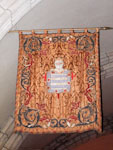 |
Coat of Arms One of the flags hanging in the chapel of the monastery denoting the coat of arms of the families of Diaz, DeSoto, Cortez, and Hernandez. These families were considered Spanish royalty. |
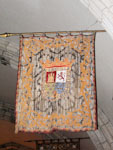 |
Coat of Arms Coat of arms hanging in the chapel of the Ancient Spanish Monastery. The words around the coat of arms read, "Castilla and Leon," which was a region in Spain, Castile and Leon, and is represented on the coat of arms by the pictures of the castle, or ... |
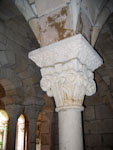 |
Column in Chapter House Detailed view of the decorative columns in the chapter house of the monastery. |
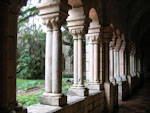 |
Columns and Arches Detailed view of the decorative columns and arches along the cloister. These features are characteristic of the romanesque architecture of the time. |
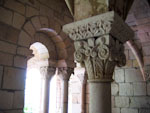 |
Columns and Arches in Chapter House Detailed view of the decorative columns and arcading arches, or rows of arches supported by columns, in the chapter house of the monastery. |
|
Next>
Last>>
|
|